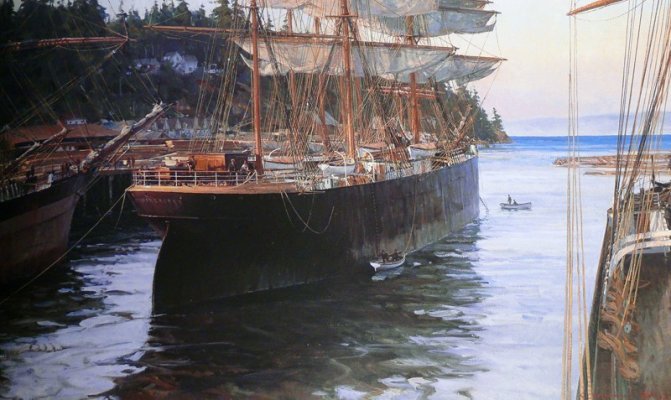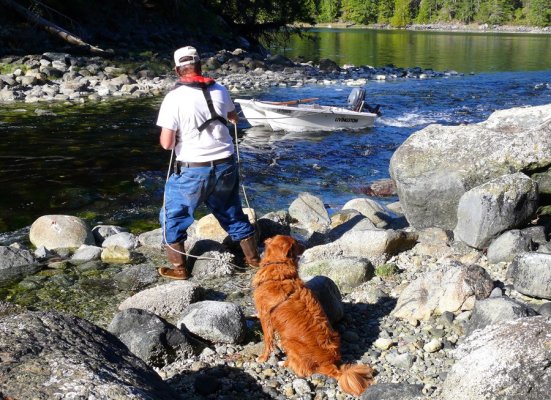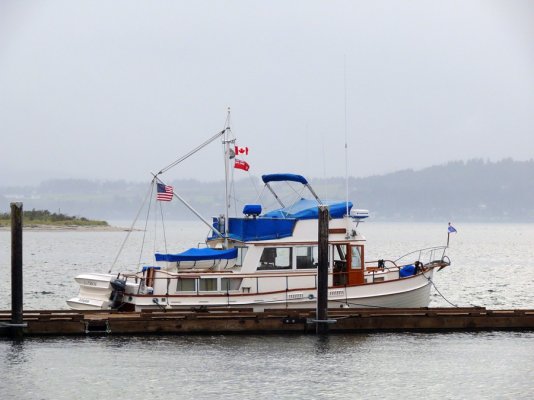Peter B wrote:
Then, when the boat moves forward under idle, with rudder towards the dock, unlike you'd expect, ie, that the bow would rub against the dock to pivot on, (but fortuitously beneficial to the paintwork, as it's nigh impossible to exactly position a fender in the right place), the boat actually takes up the slack in the line, moves out from the dock, and pivots on the for'd line, without the hull touching the dock.
This is the standard method of getting a boat off a dock that the wind or current is pushing it onto.* We use it all the time up here.*
We run the bow line under the bullrail and then back to the foredeck where my wife holds the bitter end.* Or you can take it around a cleat if the dock has them.* Most docks up here don't which is actually good because with a bullrail you can put the line wherever you want it relative to the boat.
A practice we learned from Carey is to always have at least one great big fender on the boat.* I don't mean a fender a size up from the normal ones, I mean a BIG one.* Huge would be a good description.* We carry two of them.
When we're ready to go we bring all lines aboard except the bow line that has been re-rigged around the bullrail.* My wife holds the bitter end of the bow line in one hand and one of the large fenders in the other.* We have a twin so I put the outboard (relative to the dock) engine in forward and the inboard engine in reverse and the rudder hard over toward the dock.* The propwalk moves the stern out and the thrust from the outboard prop agains the rudder moves the stern in the same direction.
The boat can't move forward because of the line my wife's holding and the bow goes hard in against the big fender she holds between the hull and the dock.* She never has any trouble positioning this fender, by the way, and since she's holding it she can move it to wherever it needs to be.
The stern powers out smartly.* If the wind is strong I add power to the engine that's in forward and often both of them.* We rarely do this maneuver at dead idle.* Usually it takes an addition of thrust against the rudder, sometimes a fair amount, to counter the wind that's pushing us onto the dock. So don't be afraid to add however much power it takes to move the stern out quickly.
The trick to making this work is to move the stern out much farther than you think you need.* The reason is that if the wind is strong--- and we've done this in winds as strong as 15 knots or so---* it will start blowing the boat back in the moment you start backing out.* Also, as you back out, the wind will blow the bow down toward the dock and since you're backing out, the chances are the bow will end up down on the boat behind you. I usually use a higher power setting than idle to back clear as quickly as possible.
So we pivot the stern out a good 60 degrees to the dock or more.* Once there, I put both engines in reverse and back us clear.* My wife lets the bitter end of the line go which runs back under the bullrail (or back around the cleat) and hauls in the end that's secured to the boat.
It takes far less time to do this it does to explain it, and it works perfectly every time.* We have gotten our boat out of a spot with only a few feet between us the boats in front of and behind us with a strong wind pushing us straight onto the dock.* It's one the handiest maneuvers we've ever learned.
This maneuver works great in single or twin engine boats.* Carey has used it to get off a dock in the same situation with his single-engine lobsterboat.* The only thing you gain with a twin is the propwalk from putting the inboard engine in reverse.* But with forward power against a hard-over rudder a single-engine boat can be pivoted out just as smartly.
In the photo below we were being shoved against the dock by winds that were blowing up to 15 knots or so.* It was still blowing like this the next morning when we left and we used the method described above to get off the dock.* Works like a charm.
*



